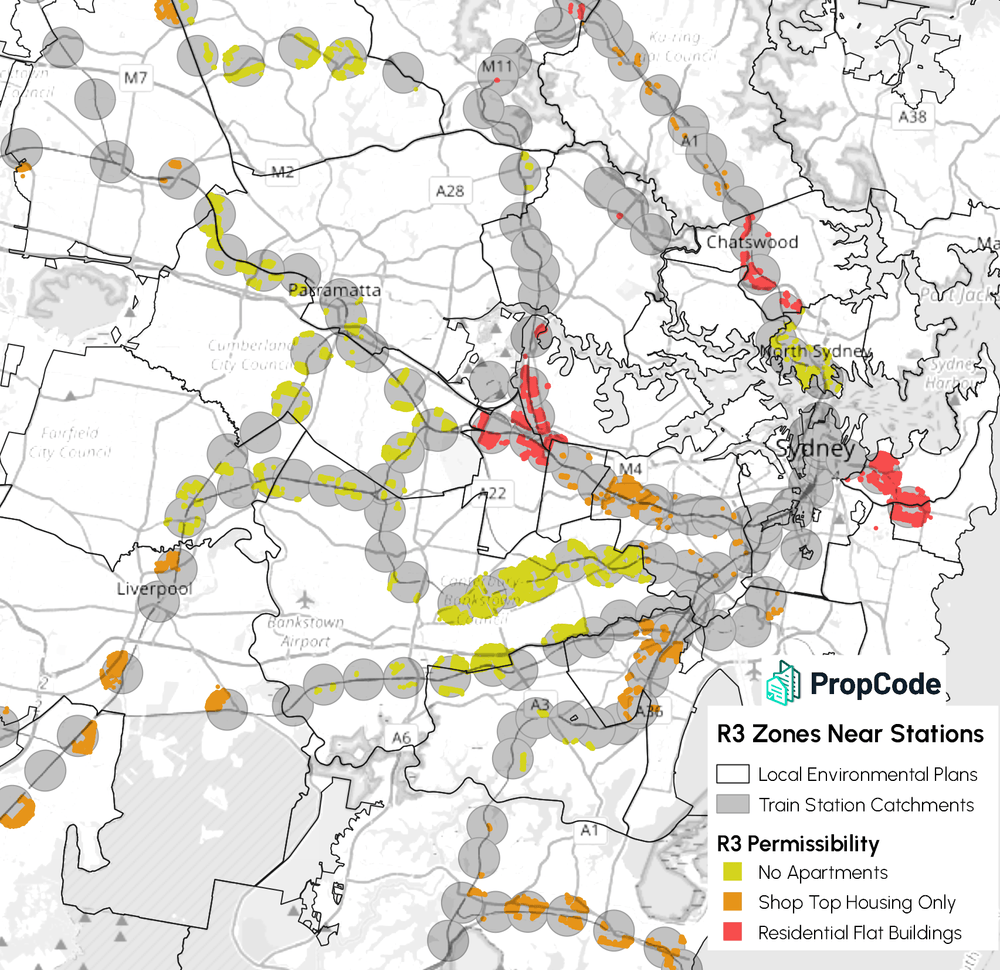(posted on 28 Nov 2023)
Big news on the housing crisis today: the NSW state government will override local planning controls to permit medium density residential buildings near transport hubs and town centres. This could be a huge win for delivery of well-located housing, but no doubt there will be Councils and communities resisting what they see as a drastic change.
UPDATE - read deeper analysis of these reforms in our follow-up article.
UPDATE 2 - request an instant analysis for your specific property here!
The Details
There are three key components to this proposal:
- dual occupancies (2 separate homes on a single lot), such as duplexes, in all R2 low-density residential zones across all of NSW.
- terraces, townhouses and 2-storey apartment blocks near transport hubs and town centres in R2 low-density residential zones across the Greater Sydney region, Hunter, Central Coast and Illawarra (the Six Cities region).
- mid-rise apartment blocks near transport hubs and town centres in R3 medium-density zones and appropriate employment zones.
PropCode’s Database
At PropCode our platform is very well suited to help users understand a big reform like this. Thanks to our extensive database of planning documents, maps, and property data, I thought this would also be an interesting case study in what we can easily analyse in greater depth.
How many properties are affected by the specific proposals released today? Answering this question requires not just spatial measurements like within 800m of train stations, but also understanding what permissibility already exists, which is different across over 100 LEPs. It's both a spatial exercise and a document text analysis exercise, and PropCode’s database can easily handle these.
1. Dual occupancies in R2 zones across NSW
At present, there are only 15 LEPs across NSW that do not permit dual occupancies in their R2 zone land use table, covering a total of approx 188,000 lots. (There are 1.15 million R2 lots that do already permit dual occupancies.) Among these LEPs, a few do currently have additional permissibility clauses for dual occupancies in certain areas, but with relatively small counts of lots affected.
2. Medium density (2-storey) in R2 zones near hubs in Six Cities
The proposal mentions “transport hubs and town centres” which is a bit vague for this analysis. I will narrow it down to all train stations to make this doable. I will also assume that the “2-storey apartment block” typology is equivalent to manor house as defined in the Codes SEPP.
Within the Six Cities region of NSW, there are approx 173,000 lots in R2 zones within 800m of a train station, spread across 35 LEPs. It is a legitimate planning question as to why these areas should remain low density if they are near high quality public transport.
Part 1 of the proposal adds dual occupancy to 41,500 of these lots that did not previously have dual occupancy.
Terraces and manor houses can only be built where multi dwelling housing is a permitted use. At present only 5 of these 35 LEPs with 31,000 lots permit multi dwelling housing in R2 zones in the land use table: Kiama, Shellharbour, Wollongong, Sutherland, and Newcastle. (Interesting that 3 of these are Illawarra!) The other 30 LEPs and 142,000 lots will thus gain permissibility for terraces or manor houses.

3. Apartments in R3 and employment zones near hubs across NSW
I’d like to make the same simplifying assumptions as above. Unfortunately without precise definitions for “transport hubs” or “town centres”, it’s difficult to get meaningful numbers for areas outside the Six Cities that generally won’t have train stations. As such, this part of my analysis is restricted to 800m around train stations in Six Cities. Additionally “appropriate employment zones” is very ambiguous, so I’ll stick with just the R3 zone.
In the Six Cities area, there are approx 43,500 lots (averaging about 950 sqm) in R3 zones within 800m of a train station, spread across 34 LEPs. Only 16 LEPs covering 15,500 lots have existing permissibility for residential flat buildings. A further 10 LEPs covering 9,500 lots have permissibility for shop-top housing, but this requires retail premises on the ground floor, so its feasibility is limited in purely residential areas. Therefore the proposal will add useful permissibility for apartments to about 28,000 R3 lots in the Six Cities area.

Summary
The three components of the proposal together appear to change permissibility on at least 216,000 lots across NSW, with the following gains:
- 188,000 R2 lots gain dual occupancy permissibility
- 142,000 R2 lots gain terraces and manor houses permissibility
- 28,000 R3 lots gain residential flat buildings permissibility
- Unknown R3 lots in regional NSW near town centres and employment zones
At a first glance this increases the statewide residential planning capacity by 100,000s of dwellings. Whether those new dwellings are feasible to build given market conditions is a wholly separate question.
The power of PropCode's database driving our platform makes analysis like this a piece of cake by combining spatial analysis with document text analysis. With a bit more time, I could also have considered more precise definitions of "transport hubs", "town centres", "appropriate employment zones", and also analysed LEP clauses that provide additional permitted uses.
To commission similar analyss for other situations, please reach out to us. And use our platform's Library and CDC tools anytime to get faster answers for your property project!
![[object Object]](https://umsousercontent.com/lib_heZDZMqkJicLuLKJ/igzynodna381foma.png?w=358)